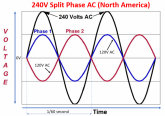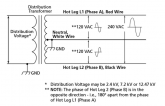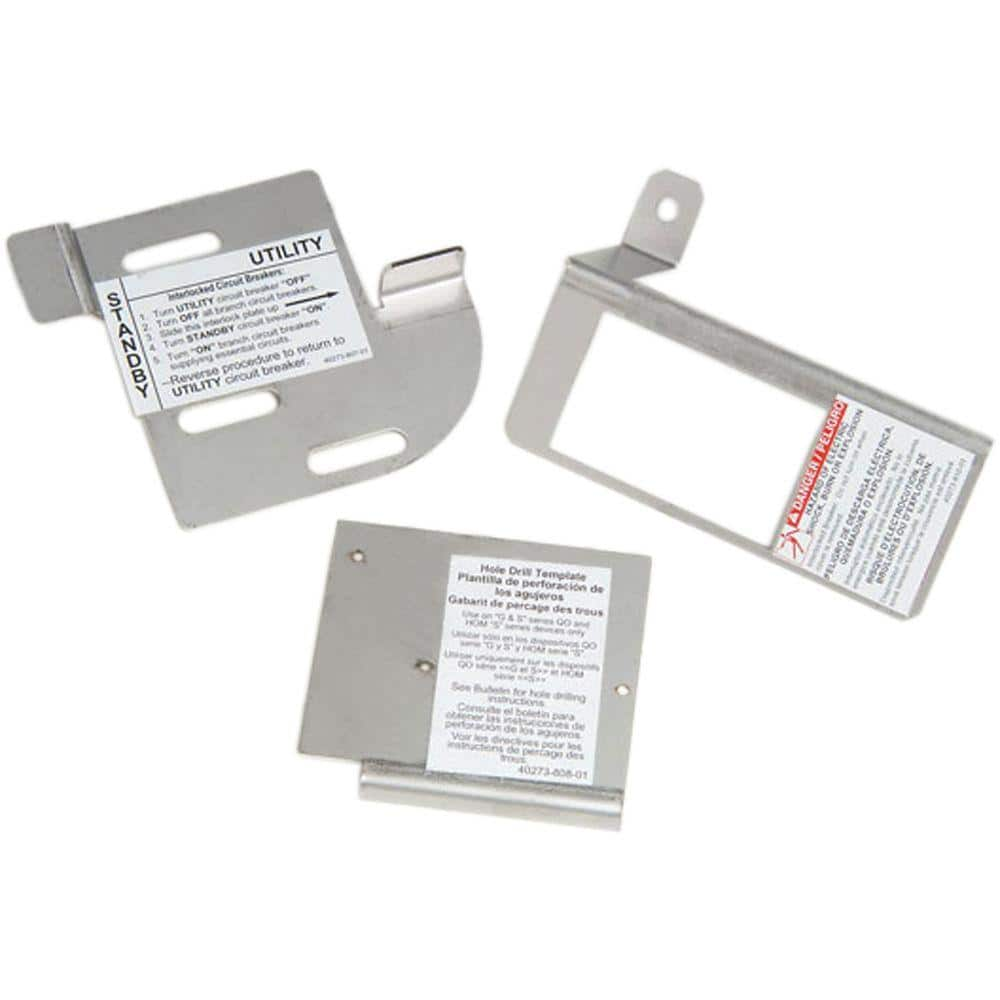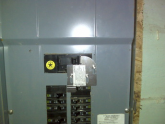You are using an out of date browser. It may not display this or other websites correctly.
You should upgrade or use an alternative browser.
You should upgrade or use an alternative browser.
Question on generator to electrical panel
- Thread starter Yessir
- Start date
FilterGuy
Solar Engineering Consultant - EG4 and Consumers
I planned on buying any 240v generator and hooking it up to a double pull beaker to back feed panel.
Questions...
Are 240v gens 180 degrees out of phase?
Would a 240v water heater need a 180 degree shift to work?
* All 240V AC devices (Including hot waters) are designed to run on a single sign wave.
* All 240V AC generators will provide a single sine wave of 240volts (RMS).
* Most 240V AC generators in the US will also provide Split phase 240v. (Split-phase 240 is what is used in US housholds)
With this, you get 3 wires: Two hot and one neutral (center tap).
- Between the two hot wires you will see a single sine wave of 240 volts.
- Between one of the hot lines and neutral you will see a single sign wave of 120V
- Between the other hot line and neutral you will see a single sign wave of 120V that is 180deg out of phase of the other 120V Hot-neutral line
Hmmmm. So if I’m back feeding my panel through a double pole breaker so both bars are hot, it doesn’t need to be 180 degrees out of phase?* All 240V AC devices (Including hot waters) are designed to run on a single sign wave.
* All 240V AC generators will provide a single sine wave of 240volts (RMS).
* Most 240V AC generators in the US will also provide Split phase 240v. (Split-phase 240 is what is used in US housholds)
With this, you get 3 wires: Two hot and one neutral (center tap).
If your hot water heater runs on 240V ac, any 240V generator with enough wattage will work. If you *also* want to run 120V appliances, you need to get a generator that provides 240V Split Phase. (I suspect that in the US, it might be hard to find a 240V generator that does not provide Split Phase)
- Between the two hot wires you will see a single sine wave of 240 volts.
- Between one of the hot lines and neutral you will see a single sign wave of 120V
- Between the other hot line and neutral you will see a single sign wave of 120V that is 180deg out of phase of the other 120V Hot-neutral line
I’ve always thought hot bars were 180 out of phase.
And thanks again for reply.
FilterGuy
Solar Engineering Consultant - EG4 and Consumers
If you have a split phase panel driving both 120V and 240V circuits you need to drive it with split phase 240.Hmmmm. So if I’m back feeding my panel through a double pole breaker so both bars are hot, it doesn’t need to be 180 degrees out of phase?
I’ve always thought hot bars were 180 out of phase.
And thanks again for reply.
People often say that in 240 split phase, the two hots are 180 degrees out of phase. That is only true in reference to the neutral. It is not true in reference to each other.
In split phase, the 120 V sign wave AC between Hot 1 (X) and Neutral is 180 deg out of phase from the 120V sign wave between Hot 2 (Y) and Neutral.
However, the 240V presented between Hot 1 (X) and Hot 1 (Y) is a simple AC sign wave.
FilterGuy
Solar Engineering Consultant - EG4 and Consumers
BTW: I found this diagram that might help.

In the diagram,
The red is what would be seen between one of the hots and neutral.
The blue is what would be seen between the other hot and neutral.
The black is what would be seen between the two hots.
Warning: The diagram implies the peak voltage is 240V. This is not true. The peak is actually much higher than 240V.
AC voltage is measured as an RMS (Root-means-square) of the signal. The RMS voltage gives the equivalent of a DC voltage through a resistive load. As an example:
For household wiring the split-phase 240 is created with a center-tap transformer


In the diagram,
The red is what would be seen between one of the hots and neutral.
The blue is what would be seen between the other hot and neutral.
The black is what would be seen between the two hots.
Warning: The diagram implies the peak voltage is 240V. This is not true. The peak is actually much higher than 240V.
AC voltage is measured as an RMS (Root-means-square) of the signal. The RMS voltage gives the equivalent of a DC voltage through a resistive load. As an example:
- 120 V AC drives 1 AC amp through a 120 ohm resister.
- 120V DC drives 1 DC amp through a 120 ohm resistor.
For household wiring the split-phase 240 is created with a center-tap transformer

Last edited:
Hedges
I See Electromagnetic Fields!
- Joined
- Mar 28, 2020
- Messages
- 20,632
I planned on buying any 240v generator and hooking it up to a double pull beaker to back feed panel.
Presumably, with an interlock so you can never have main breaker and back-feed on at the same time?
Even if this is for your house not yet on-grid, the interlock will take care of using it for backup during power failures later.
My interlock cost about $60 from Home Depot. Stupid price for a piece of sheetmetal, but it works and is UL listed.
RCinFLA
Solar Wizard
- Joined
- Jun 21, 2020
- Messages
- 3,563
Little diagram attached for typ U.S. residential
Not really legal (or safe) to feed generator into a breaker in main panel. If you do at least use spring close cap gen plug box (like 'Reliance') for some level of safety and mount box high enough outside so child cannot put fingers in plug box.
Too many things to get sequenced correctly.
1) turn off main box master breaker to grid, very important and difficult because of its spring strength.
2) Start generator
3) Plug in cord
4) make sure heavy/excessive load breakers are opened
5) close backfeed main box breaker to generator
You do not have any indication main power is back on.
Make sure gen backfeed breaker is opened first on shutdown.
Even when you know what you are doing, in an unusual/rushed situation, it is easy to screw up the sequence.
The above is only slightly more safe then male to male cord into clothes drier outlet. No male to male cords !! (called suicide cord)
Legal is breaker in main box to transfer switch in Aux box with selected loads breakers. Transfer switch selects between main breaker box and generator. Transfer switch can be a high amperage DPDT relay with coil powered by generator.
Not really legal (or safe) to feed generator into a breaker in main panel. If you do at least use spring close cap gen plug box (like 'Reliance') for some level of safety and mount box high enough outside so child cannot put fingers in plug box.
Too many things to get sequenced correctly.
1) turn off main box master breaker to grid, very important and difficult because of its spring strength.
2) Start generator
3) Plug in cord
4) make sure heavy/excessive load breakers are opened
5) close backfeed main box breaker to generator
You do not have any indication main power is back on.
Make sure gen backfeed breaker is opened first on shutdown.
Even when you know what you are doing, in an unusual/rushed situation, it is easy to screw up the sequence.
The above is only slightly more safe then male to male cord into clothes drier outlet. No male to male cords !! (called suicide cord)
Legal is breaker in main box to transfer switch in Aux box with selected loads breakers. Transfer switch selects between main breaker box and generator. Transfer switch can be a high amperage DPDT relay with coil powered by generator.
Attachments
Hedges
I See Electromagnetic Fields!
- Joined
- Mar 28, 2020
- Messages
- 20,632
Which is why I simply ordered this from Home Depo for $45:

UL listed, legal, made by the manufacturer of my breaker panel.
Safe, so long as you don't remove the cover from the panel (thereby removing the interlock) and switch it. It is labeled warning not to do that.
When you use this, you can manually turn off excessive loads (such as electric central heat) if necessary.
One reason I went with this is it helps ensure several seconds off time before switchover, because I have some equipment that may not like the sudden shift in timing of AC sine wave which would occur with a fast transfer switch.

Square D QO 150-225 Amp Indoor Load Center Generator Interlock Kit QOCGK2C - The Home Depot
Avoid the inconveniences that an unexpected power outage can cause with this QO Indoor Generator Interlock Kit. The Square D QO Cover Generator and QOM2 Frame Size Main Breaker Interlock Kit is used to
www.homedepot.com
UL listed, legal, made by the manufacturer of my breaker panel.
Safe, so long as you don't remove the cover from the panel (thereby removing the interlock) and switch it. It is labeled warning not to do that.
When you use this, you can manually turn off excessive loads (such as electric central heat) if necessary.
One reason I went with this is it helps ensure several seconds off time before switchover, because I have some equipment that may not like the sudden shift in timing of AC sine wave which would occur with a fast transfer switch.
RCinFLA
Solar Wizard
- Joined
- Jun 21, 2020
- Messages
- 3,563
Which is why I simply ordered this from Home Depo for $45:

Square D QO 150-225 Amp Indoor Load Center Generator Interlock Kit QOCGK2C - The Home Depot
Avoid the inconveniences that an unexpected power outage can cause with this QO Indoor Generator Interlock Kit. The Square D QO Cover Generator and QOM2 Frame Size Main Breaker Interlock Kit is used towww.homedepot.com
UL listed, legal, made by the manufacturer of my breaker panel.
Safe, so long as you don't remove the cover from the panel (thereby removing the interlock) and switch it. It is labeled warning not to do that.
When you use this, you can manually turn off excessive loads (such as electric central heat) if necessary.
One reason I went with this is it helps ensure several seconds off time before switchover, because I have some equipment that may not like the sudden shift in timing of AC sine wave which would occur with a fast transfer switch.
What does it do for mains input breaker? Video is a joke. Shows nothing. Says 'might eliminate need for'.
$45 for three little pieces of metal !
Best I can imagine is it prevents a generator backfeed breaker from getting turned on because of metal blocker interfering with main breaker ON position
Last edited:
Hedges
I See Electromagnetic Fields!
- Joined
- Mar 28, 2020
- Messages
- 20,632
What does it do for mains input breaker? Video is a joke. Shows nothing. Says 'might eliminate need for'.
$45 for three little pieces of metal !
Best I can imagine is it prevents a generator backfeed breaker from getting turned on because of metal blocker interfering with main breaker ON position
Exactly. It's just a stupid piece of metal that blocks the backfeed breaker normally, if held up to allow backfeed breaker to be turned on it blocks the main breaker.
And one of those is just a drilling template.

The price is ridiculous (I can buy an entire smaller panel for the same money), but what it substitutes for would cost much more.
It can interlock a 200A main and a 125A backfeed breaker. what would such a transfer switch cost?
The point is, for $45 and only a few minutes work, it does what you need for a manual transfer switch to supply any loads.
Know of any good and inexpensive transfer switches?
I have visible blade disconnects in the 30A, 60A, 100A, heavy-duty 30A, 600V AC/DC, heavy-duty 200A 600V AC/DC ranges. but not transfer switches.
I've got a 2 pole 63A supplemental breaker which is interlocked with a second 2 pole 63A. That would do the job, except it can easily transfer in about 0.1 seconds, which I don't want to do.
PHoganDive
Solar Enthusiast
Another thing to keep in mind...if your DIY method starts a fire, the insurance company may very well deny coverage due to that. The 'expensive' but approved method may not seem so expensive then.
Similar threads
- Replies
- 1
- Views
- 222
- Replies
- 12
- Views
- 481
- Replies
- 69
- Views
- 2K
- Replies
- 6
- Views
- 462


